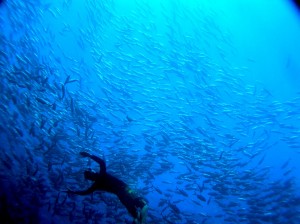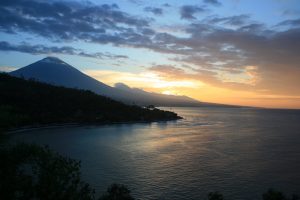May 1, 2011 | Freediving, Yoga
 Since the heyday of Jaques Mayol the vast science of yoga has been touted as the key to inspired free-diving. The benefits in this area are undoubted, from mental clarity and thoracic flexiblity to emotional well-being. The list of Yogic benefits to the Free-diver is long, less talked about are the benefits of free-diving to the student of yoga.
Since the heyday of Jaques Mayol the vast science of yoga has been touted as the key to inspired free-diving. The benefits in this area are undoubted, from mental clarity and thoracic flexiblity to emotional well-being. The list of Yogic benefits to the Free-diver is long, less talked about are the benefits of free-diving to the student of yoga.
The benefits of free-diving to the Yogi, when practiced in the right spirit, are equally profound. The most obvious of course is the control and understanding of the breath, free-diving as a door into the science of pranayama. The Aghori Tantrik Vimalananda apparently trained in Pranayama by submersing himself in the Indian ocean and Chinese masters of Tao developed breath-based energy practices with long breath holds in pools.
It’s clear that the aspects of Yoga that deal with the breath are enriched by free-diving but it’s the less obvious benefits that this Blogger is interested in, such as the way water allows for movement in a gravity free field. When coupled with a mature yoga Asana practice the forgiving nature of water allows us a fluid realignment of the body.The nature of water is that effective movement in water is fluid movement, something which every yogi or body worker aspires to.
In Yoga Asana, we work the body, disciplining it and realigning it. We test it and push it to break rigidity, to develop flexibility and make space. The body becomes fluid in its nature with movements like containers that the body flows into and fills. And this fluidity is not a thing only of ligaments and muscles, it is a thing of energy. We don’t do this for the sake of sitting in ever-more complicated postures, we do this so the body’s subtle life juices can flow better.The body becomes more permeable and energy flows better, resulting in health and a sense of lightness.
With free-diving our focus is precisely on this type of fluid movement, to move like water through water. We learn that rigid movement is wasteful movement.
A useful working definition of a yogi is one who does not waste energy, by their thoughts, words or actions. Be it holding tension, or expressing negative thoughts, the dedicated yogi tries to avoid using energy in a wasteful or self defeating manner. This conservation of energy on all levels is an essential part of free-diving.
Through meditation the Yogi slowly learns to avoid the nagging of the non-essential and to be present in the passing moment. With Free-diving we practice the art of letting go to the moment, of disciplining the body and breath so that sometimes you may go beyond the body and breath. When we dive we may feel contractions, the mind may say go up, go up, but we don’t resist, we absorb, we let the sensation move through us and any associated mental reaction is calmly observed. We observe and enjoy sensation, even so called unpleasant sensation. We become permeable to it and liquid in our reactions.
Time is limited but sometimes the moment draws out and becomes something eternal. The non-essential is left behind and there is a sense of union. This drawing together of mind and body into one focused moment is some of the essence of yoga.
Free-diving when practiced in the right way is actually a form of Oceanic yoga. Finding the stillness in fluid movement and the peace in a moment of pressure. See some training principles…
 The Ritual of the long line and the deep Blue.
The Ritual of the long line and the deep Blue.
In Bali Yoga is the work of shamans, a communication with spirits. It’s a ritual balancing act of courtesies paid to both the Gods of Mount Agung and the low spirits of the Sea and other dangerous places, such as crossroads.
The sea is considered a place of many dangerous spirits yet also a place of purification. In a romantic way we can see free-diving in the Balinese context as a ritualised confrontation with the our ‘low spirits’ of fear and needless anxiety.
When we free-dive sometimes the mind turns against us becoming mischievous or fearful. we can become plagued by our own inner ‘demons of doubt’. But with the ritual of our weighted line and safety procedures and our faith in physics we can see beyond the doubts to the deep blue face of mother nature. Then we free-dive mindfully, infused with calm and a sense of home coming.
Mar 26, 2010 | Freedive Training, Freediving
Basic physics as related to free diving and shallow water blackout
To free dive safely an elementary understanding of physics and the effects of pressure is needed. At the basic level to avoid shallow water blackout and in more advanced training to avoid lung squeeze and other pressure related injuries.
When we take a lung full of air at the surface we are breathing at one bar of pressure i.e. 1 ata, one atmosphere, that’s to say that the air we breathe is pressurized by the 10,000 metres of air above us and we use this level of pressurisation as our basic measure of pressure.
Pressure effects on volume of air.
Ten metres depth of saltwater is exerts the same pressure as one atmosphere of air so at a depth of 20 meter there is 2ata of pressure. At 20 metres there is 3 ata of pressure and so on. As air is highly compressible gas when the pressure is increased the volume of the gas will decrease in direct relation to the increase in pressure. This does not mean there is less gas; simply that it occupies a smaller volume in space. In free diving terms if we dive with a full lungful of air of 6 litres, when we reach 10 metres depth the volume shrinks to 3 litres and at 20 it will 2 litres and 30 it will 1.5litres and so on. The amount of air in our lungs in unaffected, only the volume is reduced.
What this means to the free-diver.
The reducing volume of air as we go down affects our dive in many ways, it means that airspaces need more air added to them to maintain the volume, i.e. the ears and mask need to be equalised and obviously it means the deeper we go the less air we have to equalise, tying our depth limit to an ability to equalise.
It also has another less obvious but very important effect. In simple terms the increased pressure of the air in the lungs allows the gases in the air in the alveoli to behave as if there were more of them, i.e. their partial pressure increases. This is also why scuba divers get affected by nitrogen and air cannot be used below 66 metres due to oxygen toxicity. This increase in Partial pressure also affects the free diver in a very real way as it allows the free diver to absorb O2 from the lungs at depth that he would not be able to absorb at the surface. In somewhat simplified terms; at depth the volume of air decreases, increasing the density of gases within the air. This increased density allows O2 to cross the membrane wall into the blood more easily. We can imagine it like this, the lungs shrink and the air in them is squeezed in such a way that gas exchange across the membrane wall is made easier.
Shallow water blackout and how to avoid
All this is fine, except when the breath hold diver spends too long below, while hunting a fish for example. The body still has enough 02 to function at depth because of the increased density of the air, raising the partial pressure of the lung O2, but as the diver ascends the pressure decreases and as he nears the surface the lungs expand and suddenly there is not enough partial pressure/density of O2 to allow it to cross the membrane wall. This can result in a sudden drop in accessible O2 for the body causing unconsciousness to occur, sometimes preceded by loss of motor control (samba). This can happen while getting close to the surface but normally happens on the surface when the diver exhales to take his first breath. This is the most common cause of blackout, the diver exhaling deeply on the surface after overstaying their limit at depth. To avoid this we always use recovery breaths after coming to surface i.e. we only exhale 50 percent of our air then quickly inhale as much as we can, then again exhale half of the air, repeating in this way a few times. In the way we avoid dropping the pressure in our lungs too quickly, which could, in the case of the diver being too close to their limit, induce samba or even blackout.
The cause of shallow water blackout is the change in pressure after the diver uses excessive amounts of O2 at depth. To avoid this we always dive within our limits, we always avoid overexertion particularly in the ascent and we always use recovery breathing upon surfacing.
Oct 27, 2009 | pranayama, Yoga
Kapalbhati: kapala -skull bhati- shining
A technique for cleaning the sinuses and other respiratory passages, it also stimulates the digestive organs and abdominal muscles. Kapalbhati floods the body with O2 and prana and has an energising effect on the nervous system. (more…)
Oct 27, 2009 | pranayama, Yoga
PRANAYAMA
PRANA- Universal life energy, Chi, Ki, The subtle force that permeates all matter and gives form to Chaos or in the words of the Welsh poet Dylan Thomas ‘The force that through the green fuse drives the flower’
YAMA- Control, Extension,Increase.
The breath is the primary vehicle of Prana. In Yoga breath holds are performed not in order to dive or spear-fish, but as a means of controlling and increasing the flow of subtle energy in the body. Though some of the practices in Apnea training may appear similar to some forms of Pranayama, the awareness is very different and the effects are a world apart. The effects of some of the advanced forms are powerful and should be approached with extreme caution and with the guidance of a responsible teacher. (more…)
Oct 16, 2009 | Meditation, pranayama, Yoga
Anapana is a preparatory practice for the powerful Vippassanna technique of Buddhist meditation. It is based on observation of the breath and the sensations around the nostrils and upper lip. The breath being the link between conscious and unconscious minds, observation of natural respiration is considered the obvious first step in developing subtle awareness.
The practice is simple, yet difficult to master. (more…)
 Since the heyday of Jaques Mayol the vast science of yoga has been touted as the key to inspired free-diving. The benefits in this area are undoubted, from mental clarity and thoracic flexiblity to emotional well-being. The list of Yogic benefits to the Free-diver is long, less talked about are the benefits of free-diving to the student of yoga.
Since the heyday of Jaques Mayol the vast science of yoga has been touted as the key to inspired free-diving. The benefits in this area are undoubted, from mental clarity and thoracic flexiblity to emotional well-being. The list of Yogic benefits to the Free-diver is long, less talked about are the benefits of free-diving to the student of yoga. The Ritual of the long line and the deep Blue.
The Ritual of the long line and the deep Blue.